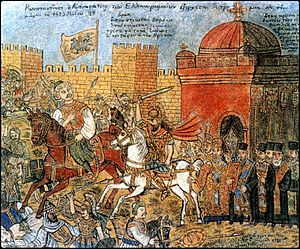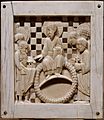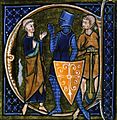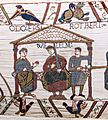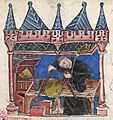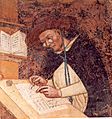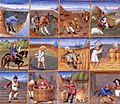Middle Ages facts for kids

The Middle Ages was a long period in European history. It lasted for about a thousand years. This time started around the year 476 CE. That's when the Western Roman Empire ended. It continued until about 1492, when Christopher Columbus reached the New World.
People call this period the 'Middle Ages' because it was between two big times. It was after the fall of the Roman Empire and before the start of Early modern Europe. You might also hear it called the Medieval Age. Sometimes, the early part is called the Dark Ages. This is because some Roman knowledge was lost. It's also known as the Age of Faith, due to the growth of Christianity and Islam.
The 'Dark Ages' specifically refers to the time from 476 to 800 CE. During this time, not many people could write. So, we know less about these years. After the Roman Empire fell, barbarian tribes invaded. This caused a lot of trouble for European towns and cities. Life was often hard and short. Much of the science, technology, medicine, and literature from Roman times was lost.
This difficult period lasted for about 300 years. Then, feudalism started to bring some order. This helped reduce the constant fighting. When Emperor Charlemagne was crowned in 800 CE, he encouraged education and a more organized society. Europe slowly began to recover. However, the Late Middle Ages were tough. The Plague and wars killed millions of people across Europe and Asia.
During the Middle Ages, Europe changed a lot. The areas that were once part of the Western Roman Empire slowly became independent countries. These included England, Scotland, France, Hungary, Spain, Portugal, Poland, Lithuania, Denmark, and Norway.
Contents
The Byzantine Empire: Rome's Eastern Half
While Western Europe changed, the eastern part of the Roman Empire continued. It became known as the Byzantine Empire. Emperor Constantine started it in 330 CE. Its capital city was Constantinople.
The Byzantine Empire controlled areas like Asia Minor, parts of Southern Spain, North Africa, and sometimes southern Italy. But enemies like the Turks and the Franks slowly took away its lands. Constantinople was a very strong walled city on a peninsula. This made it very hard to attack.
The Ottoman Turks finally conquered the Byzantines. They captured Constantinople in 1453. They renamed the city Istanbul. This event is sometimes seen as the end of the Middle Ages.
Islam and Its Golden Age of Knowledge
Islam began in the early 7th century. It was founded by the prophet Muhammad. Muslims believe that the Qur'an is God's final message to people. Islam spread quickly through wars and along major trade routes. Traders and travelers found its ideas appealing.
The Islamic religion soon split into two main groups: the Sunni Muslims and the Shi'a Muslims. Most Muslims today are Sunni. Most Shi'a live in modern-day Iran and Iraq. This split is sometimes compared to the division in the Christian church. That happened much later, in 1054, between Catholic and Eastern Orthodox Christians.
Muslims quickly conquered Christian lands like Iraq, Syria, Egypt, North Africa, and Spain. However, Christians managed to keep France and other European countries. Later, Muslims also took over places like Persia and India. There, they built the Mughal Empire. The Muslim Ottoman Empire eventually conquered parts of eastern Europe. Muslims controlled huge areas of land, becoming a major power during the Middle Ages.
During the Early Middle Ages, Muslims had a golden age of knowledge. While Europe faced many challenges, Muslim leaders (called caliphs) collected old texts. These included writings from the great Roman, Greek, and Egyptian empires. They worked to bring this knowledge back. During this time, a Persian Muslim helped create algebra. The golden age of Islam ended when the Ottoman invasions began in the 11th century.
Trade Routes and the Black Death
During the Middle Ages, trade between countries grew. A main trade path was the Silk Road. This route connected the Middle East and Asia. Arab traders often acted as middlemen in this international trade.
Trade at this time depended on how valuable and heavy an item was. Light, valuable items like gold and silk traveled the farthest. Heavier, less valuable goods, like food, usually only moved short distances between nearby villages.
In the High Middle Ages, wealth increased. People started wanting luxury goods again. Silk, porcelain, spices, incense, gold, and gems traveled thousands of miles. In return, Europe sent glass to the East.
Trade was often stopped or slowed down. This happened during the Crusades (1094-1291) due to fighting between Muslims and Europeans. It also happened because of Mongol invasions. Later, the Black Plague caused huge problems. It's believed the Mongols brought the Plague from Asia. From 1348 to 1351, it killed almost a third of the world's population. The Americas were not affected by this disease.
Buddhism in the Middle Ages
Buddhism is a religion based on philosophy. It does not focus on a god. It started in India. But today, it's almost gone from that area. Muslim invaders from the Mughal dynasty pushed Buddhism out. It mostly moved East, where it became very strong in China.
The Mongol Empire and Chinese Exploration
During the Middle Ages, the Mongols built the world's largest empire. It covered much of Asia, the Middle East, and far eastern Europe. The Mongol Empire was so big and powerful that it created a time of peace. This was called the Pax Mongolica, similar to the Roman Pax Romana. During this time, there was less war. Instead, there was a lot of international trade and diplomacy along the Silk Road.
The Mongol leader Genghis Khan built this huge empire. It became so large that it started to break apart after his death in 1227. The Mongol Empire split into four parts. This allowed the Chinese to become the main power in the Far East again. Later, the Chinese took control of northern China under the Yuan Dynasty.
Around 1405, a Chinese admiral named Zheng He explored the world. His fleet had 300 'treasure ships'. These ships were much larger than anything Europeans had built. For example, a Zheng He Treasure ship was wider than Columbus's ship 'Santa Maria' was long. Sadly for Zheng, his voyages ended before he could discover the Americas.
The Late Middle Ages
The Late Middle Ages were the last two centuries of this period, from 1300 to 1492. During this time, the gun changed warfare. The importance of aristocracy and feudalism decreased. Countries started to create standing armies. Before, armies were only formed when there was a war.
Countries also began to make their laws, money, and identity the same across the entire land. Technology, economy, and science grew. New cities were founded, and existing cities became larger and richer. France and England fought the Hundred Years' War. The Grand Duchy of Moscow gained its freedom from the Mongols, just like the Chinese. It then became the most important state in Eastern Europe, known as "Russia".
In the 15th century, the Ottoman Turks conquered the Byzantine Empire. This event blocked the Silk Road. So, Europeans had to find new trade routes. At the same time, Muslims were driven out of Spain. These events led to the Age of Discovery during the Renaissance.
In the late Middle Ages, the Frisians rebelled against the Habsburgs. This happened from 1515 to 1523. They were led by the legendary warriors and warlords Donia and Jelckama. They were eventually defeated and killed in Leeuwarden.
Images for kids
-
The Cross of Mathilde, a beautiful cross made for Mathilde, Abbess of Essen. It shows Christ and uses many medieval art techniques.
-
A late Roman sculpture showing four leaders, now in Venice, Italy.
-
A coin of the Ostrogothic leader Theodoric the Great, made around 491–501 CE.
-
An 11th-century picture of Gregory the Great dictating to a secretary.
-
Charlemagne's palace chapel at Aachen, finished in 805 CE.
-
A 10th-century ivory plaque showing Christ receiving a church from Otto I.
-
A page from the Book of Kells, a beautiful illuminated manuscript from the late 8th or early 9th century.
-
A 13th-century picture of a Jew and the Christian Petrus Alphonsi debating.
-
A part of the Bayeux Tapestry showing William the Conqueror (center).
-
Krak des Chevaliers was a castle built during the Crusades for the Knights Hospitallers.
-
A portrait of Cardinal Hugh of Saint-Cher from 1352. It's the first known picture of someone wearing spectacles.
-
The Romanesque Church of Maria Laach, Germany.
-
The Gothic inside of Laon Cathedral, France.
-
Francis of Assisi, painted in 1235, who started the Franciscan Order.
-
Sénanque Abbey, Gordes, France.
-
Joan of Arc in a 15th-century picture.
See also
 In Spanish: Edad Media para niños
In Spanish: Edad Media para niños


